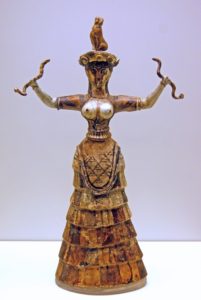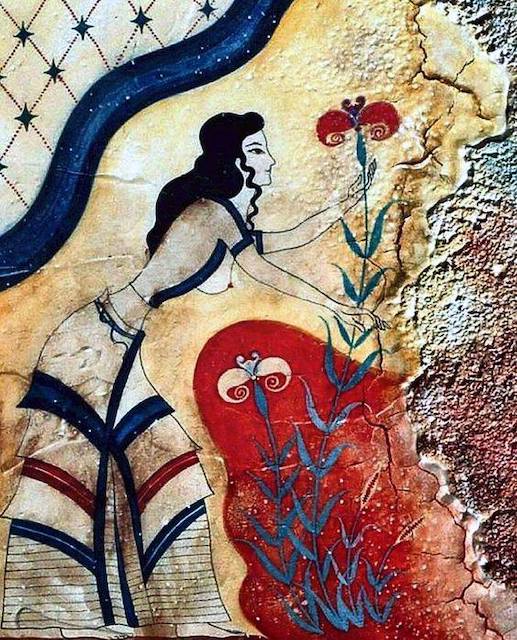“The main theme of Goddess symbolism is the mystery of birth and death and the renewal of life, not only human but all life on earth and indeed in cosmos.” — M. Gimbutas
As the days grow shorter, our thoughts naturally turn to remembrance. Across many cultures, the Autumn season is associated with remembering the departed and honoring their lives.
As we approach the threshold between the months of October and November, many may be drawn to celebrate the Celtic pagan Samhain harvest festival or Day of the Dead, a festive occasion in Mexico where people honor relatives by bringing food and flowers to the cemeteries. Certainly, we are drawn to remembering our ancestors.
These types of celebrations are joyous. They are an important part of most cultures, as they remind us of our human connection to the natural cycle of life and death. In our daily life, it is easy to forget what and who has become before.
Without the legacy of our ancestors, none of us would exist at all!
Our ancestor’s legacy contains great wisdom, even if we don’t know who they were. They each lived and learned before us, and we can call upon our ancestors to guide us with that wisdom. Ancient and indigenous people have a completely different perspective about their relationship with themselves, the plants, and animals around them, and each other than we do today.
It is through our ancestors that we learn about our present and future, and we wouldn’t understand our place as women in the scope of history without them. They tell us what was valued and revered.
The Sacred Feminine in Ancient Minoan Culture
The ancient Minoan matriarchal culture and their unique portrayal of women as Goddess and Priestess provide a glimpse into our true essence, where a fusion of the sacred and secular influenced their culture. They show us the sacred powers women have been imbued with since time began.
Ancient Minoans clearly emphasized the role of women in religion and society. Frescos and figurines uncovered at Knossos portray females as figures of power and respect. The goddess figurines excavated at other sites on the island are made of clay and have simplified forms; they are often referred to as “Goddesses with raised arms.”
The Minoans worshipped the Goddess inside the palace of Knossos, in small temples, in caves, and on mountaintops. The unearthed artifacts reveal a people who had developed a high degree of respect for the female form and a keen eye for observing and adopting to their physical environment.
There are female figurines with doves on their shoulders, a cat on her head, as well as scenes of dolphins and other animals, floral vines, and plants that were depicted on many of the frescoes. In Minoan art, a society of joyful disposition is expressed, in harmony with their surroundings, as well as awe at the logical order of the natural world.
The enigmatic Snake Goddess
Though the Goddess is ONE, she generously assumes many forms. In the Minoan culture, she is nature in the form of a mother goddess. As the Snake Goddess (ca.1600 BC), she is depicted as bare-breasted and holding snakes in her hands.
Snakes were revered in ancient matriarchal cultures, and they were among the most respected animals. It is possible that the worship of the Minoan Snake Goddess was representative of the symbolic cycle of rebirth, regeneration, or renewal of life.
A symbol of femininity, snakes were regarded as instinctual, sacred, and wise creatures that are closely related to women as the givers of life. The snake is the primal symbol of the eternally renewing power of fertility. The Snake Goddess has the feminine characteristics of being intuitive, mysterious, and enigmatic.
The snake’s molting is intimately associated with the soul’s quest for self-realization, elevating it to the status of a symbol of life as it renews itself. Snakes can symbolize our ability to discard everything we have outgrown, such as bad habits and old beliefs, and move toward higher levels of awareness and spiritual energy.
Ritually created at the sacred site of Knossos, Crete, Fleur Regeneration Ritual Essence energetically absorbed the power of place and captured the ancient regenerating qualities of the Sacred Feminine. This vibrational essence connects us to the cycles of life and death, the process of renewal, replenishment, and restoration that leads us to embody and empower the legacy of the Sacred Feminine.
In learning from our ancestors, places, and the animals associated with the timeless regenerative energy of the Snake Goddess, we also open ourselves to the keepers of the wisdom of the ancestors. We are reminded of the sacred process of transformation required to become wise women by the regenerative mysteries of the Sacred Feminine.
Through us, the miraculous ability to create life from our bodies, our cycles of fertility that mirror the moon’s waxing and waning have represented the mystery of the Sacred Feminine and connection with the Goddess.
Our renewed perspective of ourselves as just a small part of a greater whole allows us to tap into a seemingly magical and transformative power of the Goddess. That’s what Fleur Alchemical Wellness Care inspires.
However you celebrate the remembrance of your ancestors this year, I invite you to lift your consciousness to new heights as you become aware of the Sacred Feminine and the legacy of the Minoan Snake Goddess.
Use Fleur Regeneration Ritual Essence to call forth the Minoan’s regenerative power to restore the Sacred Feminine’s authentic liveliness, self-love, and soulful joy as your own.
In Her Remembrance,
Love,
Vidya

